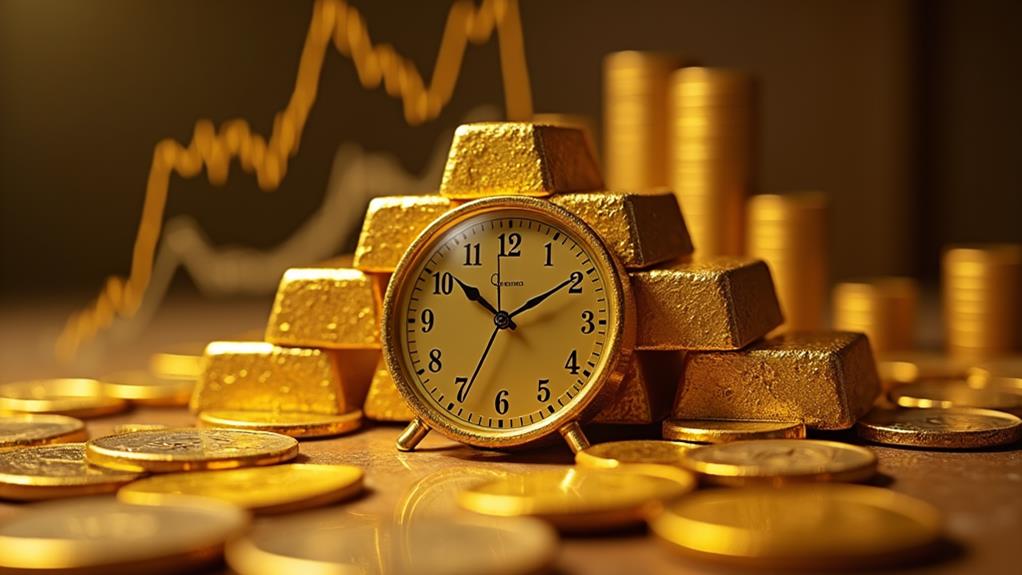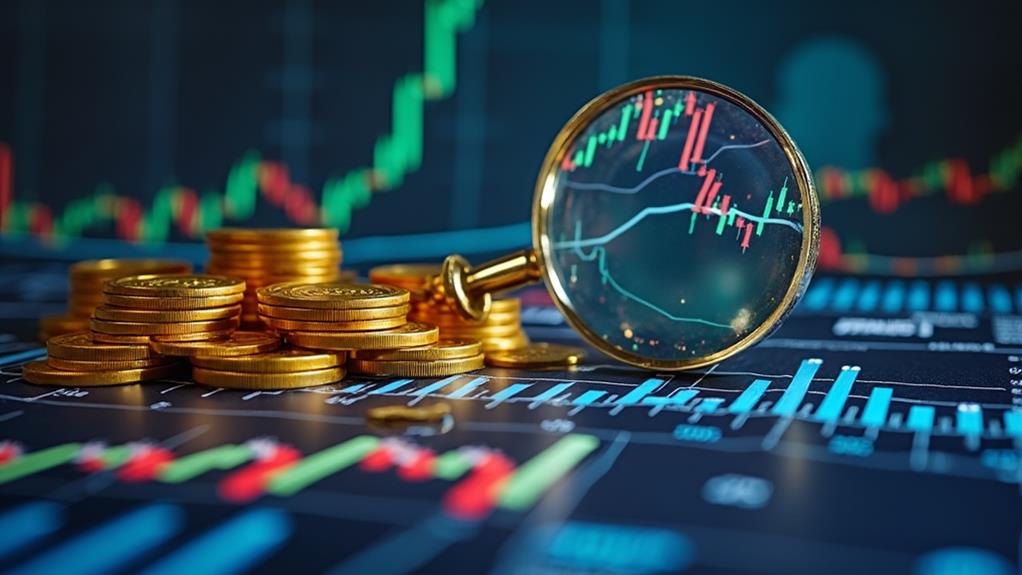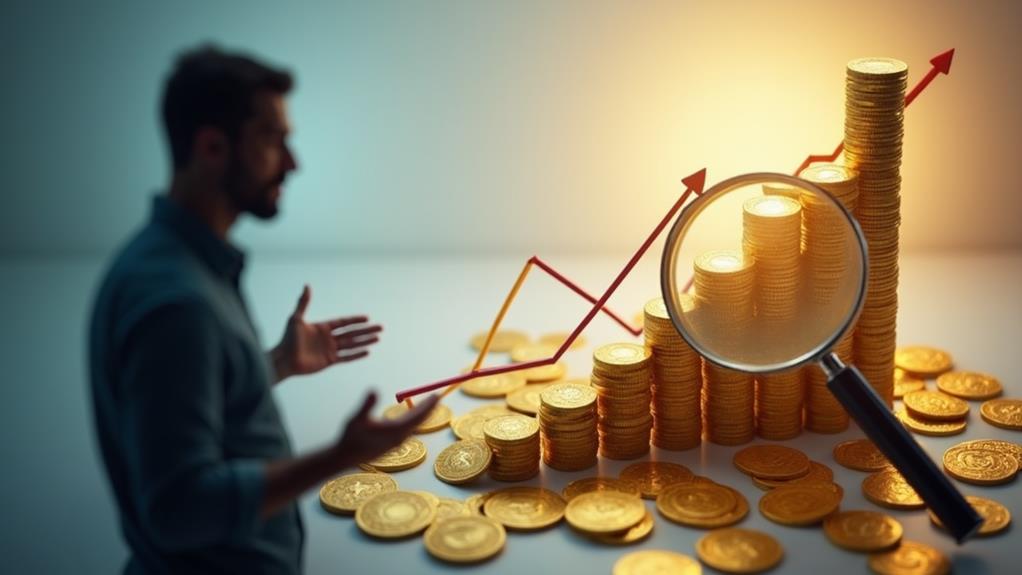Timing gold investments can be a complex pursuit, but Peter Schiff's insights offer valuable guidance for navigating this precious metal's market. Schiff, a renowned economist and gold advocate, emphasizes the importance of understanding global economic trends and their impact on gold prices. By analyzing crucial indicators and central bank policies, investors can identify opportune moments to enter or exit the gold market. Nevertheless, successful gold investment timing requires more than merely economic knowledge; it additionally demands a sharp eye for technical analysis and an understanding of geopolitical factors. As we investigate Schiff's approach, investors will uncover a comprehensive framework for making informed decisions in the dynamic world of gold investing.
Key Insights
- Monitor central bank policies, particularly Federal Reserve actions, to anticipate shifts in gold prices.
- Analyze inflation rates and currency devaluation trends to identify opportune moments for gold investment.
- Focus on long-term investment strategies rather than short-term speculation in the gold market.
- Use technical analysis tools like moving averages and RSI to refine investment timing decisions.
- Stay informed about geopolitical factors and global economic trends that can influence gold's safe-haven appeal.
Understanding Gold's Economic Role

Gold has long been considered a safe-haven asset and a hedge against economic uncertainty. As a precious metal, gold bullion serves as an inflation hedge, protecting wealth during periods of currency devaluation. During economic recessions, investors often turn to gold as a store of value, driving up demand and prices.
Central bank policies, particularly those of the Federal Reserve, significantly influence gold market trends.
Understanding gold's economic role involves recognizing its unique position in the global financial system. As a diversification strategy, gold offers stability to investment portfolios, counterbalancing more volatile assets.
The gold supply and demand dynamics play an essential role in determining its value, with factors such as mining production, industrial use, and investor sentiment affecting prices.
Experts often recommend allocating a portion of one's portfolio to gold as a safeguard against economic downturns and geopolitical uncertainties.
Schiff's Market Cycle Analysis
Analyzing market cycles is a vital aspect of gold investment timing, and Peter Schiff's approach offers valuable insights. Schiff, a renowned gold-bug, emphasizes the importance of understanding global economic trends and central bank policies when timing gold investments.
His market cycle analysis focuses on:
- Identifying periods of economic instability
- Monitoring central bank actions and their impact on gold prices
- Assessing the purchasing power of fiat currencies
Schiff argues that gold serves as a hedge against economic crises and currency devaluation. He advises investors to consider gold as a long-term investment strategy, rather than attempting to time short-term market fluctuations.
According to Schiff, "Gold should be a core holding in every investment portfolio, especially during times of economic uncertainty."
Key Economic Indicators to Watch

When evaluating gold investments, it's essential to monitor important economic indicators, particularly inflation rates and currency exchange fluctuations.
Inflation rates and trends can significantly impact the value of gold, as investors often turn to this precious metal as a hedge against rising prices.
Likewise, currency exchange fluctuations, especially in major global currencies like the US dollar, can influence gold prices and investment opportunities in the market.
Inflation Rates and Trends
Among the essential economic indicators that investors should monitor when timing their gold investments, inflation rates and trends stand out as particularly significant.
As a hedge against inflation, gold often sees increased demand when the value of fiat currencies declines. Peter Schiff, a renowned gold-bug, emphasizes the importance of understanding inflation's impact on the price of gold.
Investors should consider:
- Current inflation rates
- Central bank policies
- Consumer Price Index (CPI) trends
- Producer Price Index (PPI) data
- Wage growth statistics
These factors can influence the gold spot price and potentially affect long-term growth in a portfolio.
As inflation erodes the purchasing power of currencies like the dollar, many investors turn to gold bullion as a store of value.
Nevertheless, it's vital to keep in mind that while gold can offer protection against inflation, its price can be volatile in the short term.
Currency Exchange Fluctuations
Currency exchange fluctuations play an important role in determining the optimal timing for gold investments. As the U.S. dollar weakens against other major currencies, the price of gold typically rises, making it an attractive investment option.
On the other hand, a stronger dollar often leads to lower gold prices. Investors should closely monitor currency exchange rates, particularly between the U.S. dollar and currencies like the euro, yen, and Swiss franc.
Peter Schiff, CEO of SchiffGold, advises, "Understanding currency exchange fluctuations is vital for timing gold investments. When the dollar weakens, it's often an opportune time to buy gold and silver."
Key factors to consider:
- Global economic events affecting currency values
- Central bank policies and interest rates
- Trade balances and geopolitical tensions
Central Bank Policies' Impact
Central bank policies play an essential role in shaping the gold market, with their decisions often having far-reaching consequences for investors.
Interest rates, set by central banks, have an inverse relationship with gold prices, as higher rates typically make gold less attractive compared to interest-bearing assets.
Quantitative easing programs and currency devaluation efforts by central banks can significantly impact gold's value, often driving investors towards the precious metal as a safe-haven asset during times of economic uncertainty.
Interest Rates Affect Gold
Interest rates play a vital role in shaping gold's market value, with central bank policies exerting significant influence. According to gold-bug Peter Schiff, understanding this relationship is essential for investors looking to time their gold investments best. As interest rates fluctuate, the attractiveness of gold as an investment changes, impacting its price.
Key points to keep in mind when evaluating interest rates' effect on gold:
- Higher interest rates typically make yield-bearing assets more appealing
- Low rates often enhance gold's appeal as a safe-haven asset
- Central bank decisions on interest rates can cause rapid price movements
- Long-term interest rate trends may signal broader economic shifts
- Real interest rates (adjusted for inflation) are particularly important
Investors contemplating a gold IRA or adding precious metals to their portfolio should closely monitor interest rate developments.
As we approach 2024, understanding this dynamic becomes increasingly vital for those seeking to protect and grow their wealth through gold investments.
Quantitative Easing Influence
Quantitative easing (QE), a monetary policy tool employed by central banks, significantly impacts gold prices and investment timing. As central banks inject liquidity into the economy, the value of fiat currencies often decreases, making gold more attractive as a store of value.
Peter Schiff, a renowned economist hyper-focused on gold, believes QE policies can lead to inflation, potentially driving up gold prices.
Investors evaluating gold or silver should carefully monitor QE activities when deciding to buy or sell. Physical gold storage, including gold bars and gold coins, may become more appealing during periods of extensive QE.
Nevertheless, it's vital to allocate investments wisely and consult with a broker before making decisions. Schiff advises investors to think long-term, stating, "I think it's going to be a bumpy ride, but gold's ultimate destination is much higher."
Currency Devaluation Implications
While closely related to quantitative easing, currency devaluation represents another vital factor in timing gold investments. As central banks engage in policies that weaken their currencies, the value of gold often rises.
Peter Schiff, a noted gold advocate, has emphasized the importance of understanding these implications:
- Gold mining stocks may benefit from currency devaluation
- Gold and silver products become more attractive as currency weakens
- Timing is essential; buy gold while it's still undervalued
- Currency devaluation can make existing gold holdings worth a lot more
- The effects of devaluation on gold prices are often artificial and temporary
Schiff has admitted he could have made a lot more money over the last decade by timing his investments more precisely.
Nevertheless, he maintains that long-term gold ownership remains a hedge against currency devaluation. Investors should be cautious and well-informed when contemplating gold investments in response to currency fluctuations.
Geopolitical Factors Affecting Gold

Numerous geopolitical factors can significantly influence the price of gold, making it crucial for investors to stay informed about global events.
Peter Schiff's analysis emphasizes the importance of understanding these factors when investing in precious metals like the American Gold Eagle or other bullion products. Geopolitical tensions, trade disputes, and economic penalties can drive investors towards the yellow metal as a safe haven.
For example:
- Political instability in major economies
- International conflicts or threats of war
- Changes in global trade agreements
- Currency manipulation by foreign governments
These events can impact the value of platinum and palladium as well.
Goldco and other reputable dealers often provide insights into how geopolitical factors affect gold prices. Investors should carefully consider these elements when timing their purchases of gold coins or other precious metals, as they can significantly influence market trends and investment outcomes.
Technical Analysis for Gold Timing
Technical analysis provides investors with valuable tools for timing their gold investments. Peter Schiff's SchiffGold recommends monitoring significant indicators relative to gold prices. These include:
- Moving averages
- Relative Strength Index (RSI)
- Fibonacci retracements
- Bollinger Bands
- Volume trends
When evaluating gold purchases, investors should assess popular gold coins like the American Eagle and Canadian Gold Maple Leaf. Fractional gold coins offer flexibility, while 1-ounce coins are standard for larger investments.
Schiff advises that the end of 2023 may present opportunities, but cautions against relying merely on technical analysis. Fundamental factors, such as geopolitical events and economic policies, should likewise be taken into account.
Investors must balance short-term timing strategies with long-term wealth preservation goals. Regular portfolio reassessment is essential; it may be time to unsubscribe from certain investment strategies if they no longer align with market conditions.
Building a Gold Investment Strategy

How can investors construct a strong gold investment strategy? According to Peter Schiff's exclusive interview with Birch Gold Group, a well-rounded approach is essential. SchiffGold's integrity and experience suggest diversifying metals investments across coins and bars, allocating a portion of one's total net worth to precious metals. This strategy helps people invest wisely, potentially outperforming their wealthy peers.
Key points to consider:
- Determine investment goals and risk tolerance
- Research reputable dealers with proven track records
- Decide between physical gold and gold-backed securities
- Establish a systematic buying plan to average costs over time
- Consider storage options: home safe, bank vault, or third-party depository
Schiff emphasizes the importance of education and patience when building a gold investment strategy.
My Final Thoughts
Gold, a shining light in uncertain economic times, demands shrewd timing for optimal investment. Like a chess game, successful gold investment requires strategic moves based on global economic indicators, central bank policies, and geopolitical shifts. Technical analysis tools serve as a guide, directing investors through market fluctuations. By synthesizing these elements, investors can traverse the golden labyrinth of opportunities, potentially reaping rewards while mitigating risks. Vigilance and informed decision-making remain essential in the dynamic landscape of gold investment.







